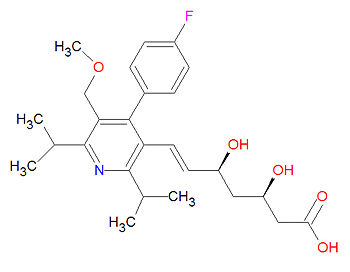Cerivastatin: Difference between revisions
imported>David E. Volk (New page: {{subpages}} [[Image:Cerivastatin structure.jpg|right|thumb|350px|{{#ifexist:Template:Cerivastatin structure.jpg/credit|{{Cerivastatin structure.jpg/credit}}<br/>|}}Cerivastatin, a type II...) |
imported>Caesar Schinas m (Bot: Update image code) |
||
| (5 intermediate revisions by 2 users not shown) | |||
| Line 1: | Line 1: | ||
{{subpages}} | {{subpages}} | ||
{{Image|Cerivastatin structure.jpg|right|350px|Cerivastatin, a type II statin.}} | |||
'''Cerivastatin''', sold as '''Lipobay''', '''Rivastatin''' and '''Baycol''', ''now withdrawn from the U.S. and Canadian markets'', is a type II statin formerly used to treat high cholesterol levels ([[hypercholesterolemia]]), prevent [[myocardial infarction|heart attacks]] and [[stroke]]s, and to diminish the formation of [[atherosclerosis|arterial plaque]]. Baycol was voluntarily removed from the U.S. market in August of 2001 by Bayer Pharmaceutical Division due to reports of fatal [[rhabdomyolysis]]. | '''Cerivastatin''', sold as '''Lipobay''', '''Rivastatin''' and '''Baycol''', ''now withdrawn from the U.S. and Canadian markets'', is a type II statin formerly used to treat high cholesterol levels ([[hypercholesterolemia]]), prevent [[myocardial infarction|heart attacks]] and [[stroke]]s, and to diminish the formation of [[atherosclerosis|arterial plaque]]. Baycol was voluntarily removed from the U.S. market in August of 2001 by Bayer Pharmaceutical Division due to reports of fatal [[rhabdomyolysis]]. | ||
It is a [[Hydroxymethylglutaryl-coenzyme A reductase inhibitor|HMG-CoA reductase inhibitor]] which diminishes the conversion of HMG-CoA to [[mevalonate]], a key chemical precursor of [[cholesterol]]. | It is a [[Hydroxymethylglutaryl-coenzyme A reductase inhibitor|HMG-CoA reductase inhibitor]] which diminishes the conversion of HMG-CoA to [[mevalonate]], a key chemical precursor of [[cholesterol]]. | ||
It is structurally related to the other [[type II statin]]s, [[fluvastatin]], [[atorvastatin]] and [[rosuvastatin]]. | It is structurally related to the other [[type II statin]]s, [[fluvastatin]], [[atorvastatin]] (Lipitor) and [[rosuvastatin]] (Crestor). | ||
== brand names == | == brand names == | ||
| Line 30: | Line 29: | ||
* [[Rifabutin]], a rifamycin, decreases the effect of statin drug | * [[Rifabutin]], a rifamycin, decreases the effect of statin drug | ||
* [[Rifampin]], a rifamycin, decreases the effect of statin drug | * [[Rifampin]], a rifamycin, decreases the effect of statin drug | ||
== External links == | |||
{{CZMed}} | |||
Latest revision as of 06:31, 8 June 2009
Cerivastatin, sold as Lipobay, Rivastatin and Baycol, now withdrawn from the U.S. and Canadian markets, is a type II statin formerly used to treat high cholesterol levels (hypercholesterolemia), prevent heart attacks and strokes, and to diminish the formation of arterial plaque. Baycol was voluntarily removed from the U.S. market in August of 2001 by Bayer Pharmaceutical Division due to reports of fatal rhabdomyolysis. It is a HMG-CoA reductase inhibitor which diminishes the conversion of HMG-CoA to mevalonate, a key chemical precursor of cholesterol. It is structurally related to the other type II statins, fluvastatin, atorvastatin (Lipitor) and rosuvastatin (Crestor).
brand names
- Baycol (withdrawn from US and Canadian markets)
- Lipobay
- Rivastatin
Drug interactions
- Bezafibrate increases the risk of myopathy/rhabdomyolysis
- Bosentan could decrease the statin effect
- Clarithromycin, a macrolide, possibly increases the statin toxicity
- Colchicine increases the risk of rhabdomyolysis
- Cyclosporine may cause myopathy and rhabdomyolysis
- Diltiazem increases the effect and toxicity of the statin
- Erythromycin a macrolide, possibly increases the statin toxicity
- Fenofibrate increases risk of myopathy/rhabdomyolysis
- Gemfibrozil increases risk of myopathy/rhabdomyolysis
- Imatinib increases the effect and toxicity of statin
- Itraconazole increases the risk of myopathy/rhabdomyolysis
- Josamycin, a macrolide, possibly increases the statin toxicity
- Ketoconazole increases the risk of myopathy/rhabdomyolysis
- Nefazodone increases the effect and toxicity of the statin drug
- Quinupristin presents an increased risk of toxicity
- Rifabutin, a rifamycin, decreases the effect of statin drug
- Rifampin, a rifamycin, decreases the effect of statin drug
External links
The most up-to-date information about Cerivastatin and other drugs can be found at the following sites.
- Cerivastatin - FDA approved drug information (drug label) from DailyMed (U.S. National Library of Medicine).
- Cerivastatin - Drug information for consumers from MedlinePlus (U.S. National Library of Medicine).
- Cerivastatin - Detailed information from DrugBank.
